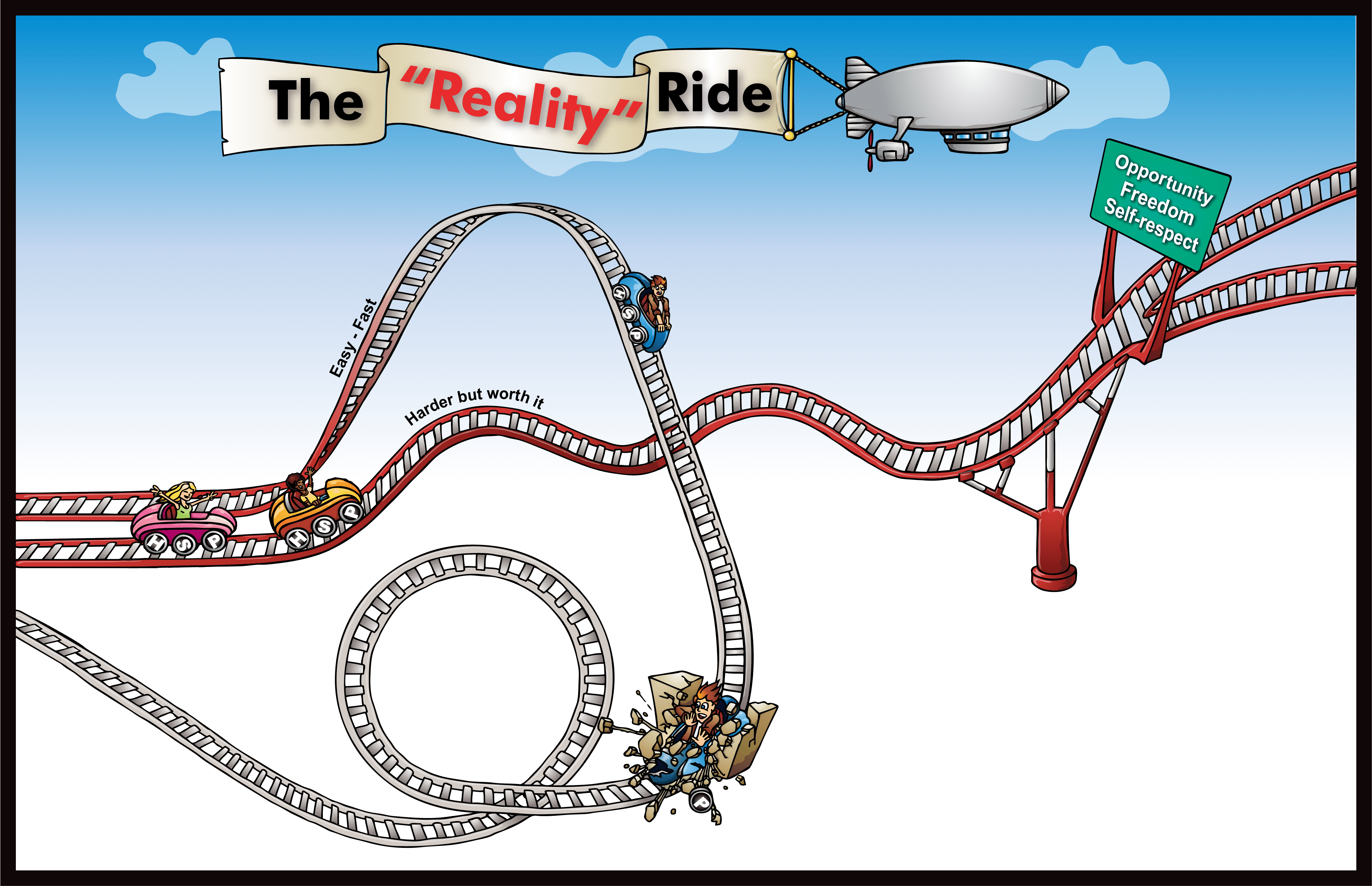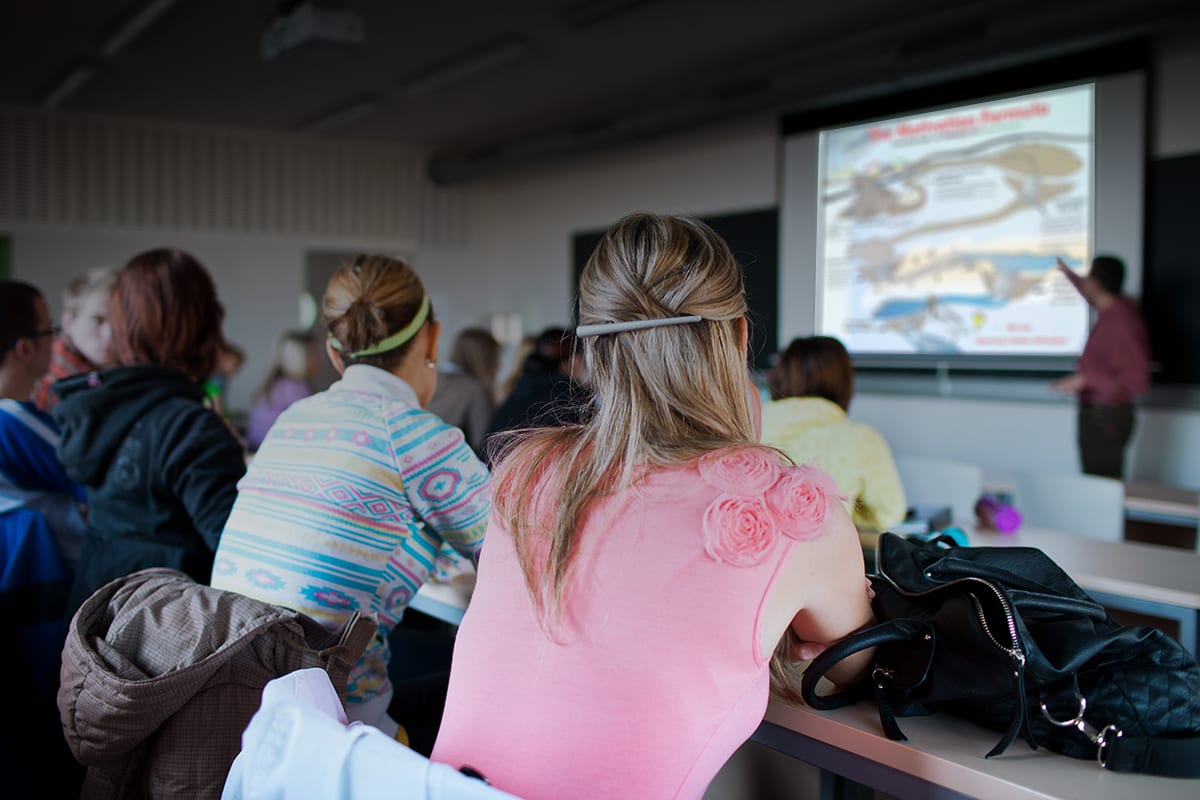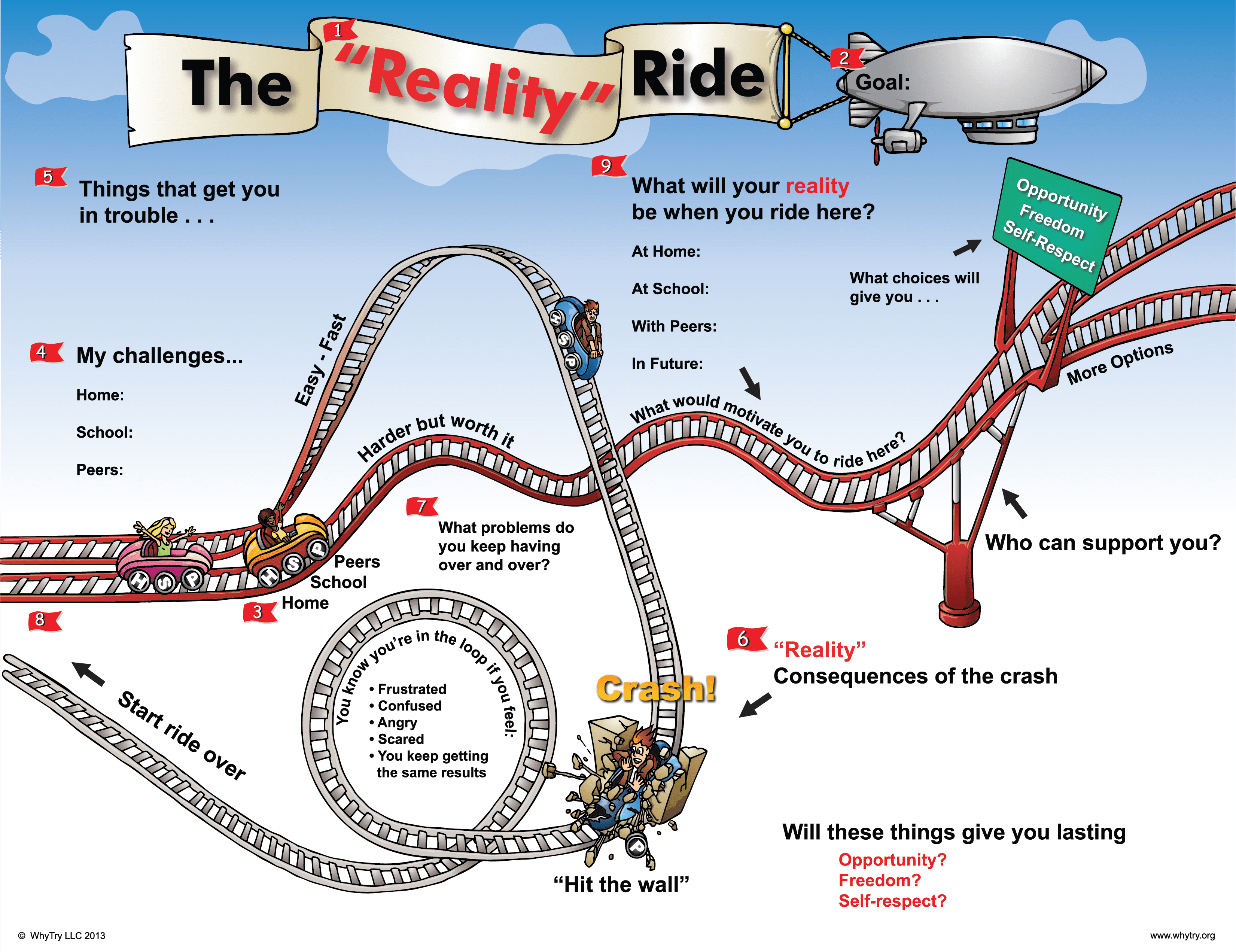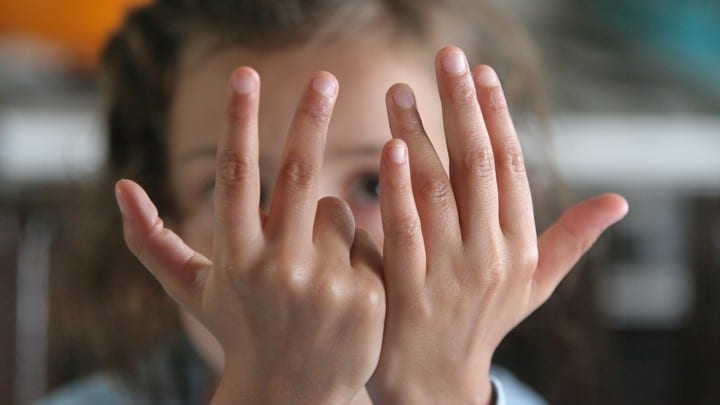Reality Ride Sample Lesson – Secondary
Core Competency: Using Video
Get Started
With the Lesson Plan PDF
Learning Objectives:
- I can explain how a decision will lead to real consequences; whether positive or negative.
- I can explain how decisions can lead us closer to our goals.
- I can connect events in my life with choices I have made, both positive and negative.
- I can explain how the two tracks apply to my life.
Lesson Preparation:
This lesson will introduce the Reality Ride metaphor in order to help students make connections between the choices they make in life and the consequences (or reality) of those choices. You will use video and an activity to help you teach the metaphor. After going through the metaphor you will give the students to share their understanding through a student booster (art or journal project).


Lesson Tools:
(links found above)
- Lesson Plan PDF. You can use the PDF or this webpage, whichever you prefer. The Lesson Plan will guide you through your lesson.
- PowerPoint Deck For Windows. You can use this to present to your group during your lesson.
- Keynote Deck For Mac. You can use this to present to your group during your lesson.
- Make sure the Emotional Rollercoaster video in the Lesson Plan works and is cued ready to go. Practice sharing the video and stopping it at key moments.
- Read through and practice the Activity: Count Your Fingers if you have never used it before. You can download the instructions for this activity above, or read them on this page at the activity section.
- Have the supplies necessary for the Reality Ride Journal Booster #4 student booster (art or journal project).
Setting the Class
(5-10 minutes)
Attention Getter
As students come in choose a song to be playing. You could pull a song from the Suggested Playlists in the Reality Ride toolkit or you could play a popular song to build atmosphere. Either way, this is also a great moment to Surrender the One Up by greeting students by name and talking and asking them about things outside of school that you know about them.


Ask if anyone in class has a celebration to share since you last met as a WhyTry group. You may be prepared to share your own. (NOTE: Celebrating one another is an important ritual to establish with your class and may take some time for everyone to embrace; however be consistent and positive. This will lead to buy-in and participation).
Share a simple outline for the day which includes you are excited to discuss a lesson about a screaming kid, roller coasters, and the Harder But Worth It track. Review the Life Rules you established last class period.
Core Competency
Using Video
Video Instructions: As a WhyTry facilitator, you will use video often. We love to tap into the media around us in a positive way to engage with our students and to grab their attention. Media is a major part of their world. We want to use it to make learning relevant. To use videos effectively, there are several indicators you want to demonstrate in your use. Read our indicators for successfully using video and watch this tutorial for using videos in your lessons.
Video
5 minutes
Prepare to show the video Emotional Rollercoaster from the Reality Ride Toolkit. To set the stage ask the following questions:
- Who has ridden on a roller coaster?
- Who likes roller coasters?
- Why?
- Who doesn’t like roller coasters?
- Why not?
Facilitate a short discussion about what its like to ride roller coasters and then preface the video with a statement like this: We are going to watch a short video clip to see the emotions that a boy goes through as he rides a roller coaster for the very first time.
Show the video clip and pause it at a previously planned point before the boy goes over the top of the Roller Coaster. Ask What do you think the boy is feeling up until now? Show more of the clip. Pause the video a few seconds later at a previously planned point where the boy is on the downward side of the roller coaster and is showing obvious fear. Ask What do you think the boy is feeling now? Facilitate more answers and then show the rest of the clip. Transition to the next step of the lesson.
Facilitate a discussion how sometimes life can feel like a Roller Coaster filled with Highs and Lows. You can ask questions to students about the Highs and Lows that come in their lives or that they’ve seen in the lives of other people. Explain that today you will be talking about a specific Roller Coaster and discussing how it applies to life.
Metaphor Walkthrough
30 minutes including activity
Whether you are using the PowerPoint Tool, projecting the metaphor, or providing individual copies, follow the sequence annotated by the red flags on the metaphor. It will be a guide to help you walk the students through the Metaphor:



Discussion Points
Discussion Point #1:
Ask the question: What does the word “reality” mean to you? Facilitate a discussion and emphasize that reality is what is real or what is actually happening in our lives. You could have students write down their definition of “reality” underneath the word “Reality” on their copy of the picture. To help increase understanding, you can also compare and contrast the difference between reality and what is not reality.
Discussion Point #2:
Say: To better understand the point of this Roller Coaster, I need you to think of a goal. Ask: What is a goal that you have for your life? Let students know that to get on this reality ride, they need to identify one goal or dream for their life. Discuss that they can have any goal, as long as it doesn’t break the following rule: The goal can’t hurt themselves or others. It must be a positive goal. (Note: You may not like the goal that they choose, but as long as it doesn’t hurt them or others, just “go with it” for now. Often students have unrealistic goals or dreams, but it’s best not to get hung up on those. We use the goal to inspire them to take the harder but worth it track later in our discussion)
Discussion Point #3:
Ask the question: What are the three main environments where you spend most of your time? Quickly discuss that the three wheels have the letters H, S, and P on them. These represent the three main places where they spend their time: at home, at school, and with peers. Ask the students, “What do the wheels do for the roller coaster?” (They take the roller coaster down the track.) Say just like the wheels take the cars down the track, we make a lot of decisions in our lives in those three places. We also have a lot of challenges come up in those three places.
Discussion Point #4:
Ask the questions one at a time: What are some of your challenges at home? at school? and with peers? Note: If you are teaching this one-on-one, you may ask personal questions about some of their challenges at home, at school, and with peers. (If you are working with a group, it’s best to keep your questions general. For example, “What are some of the challenges that kids your age have at home?” Students can feel very uncomfortable answering personal questions about their home life in front of a group.) As you go through each question, list answers for all to see or have them write on their own copy. Examples of student responses may include the following: At HOME: Too many rules, bored, parents too strict, divorce, fighting, no money, can’t communicate with parents, etc. At SCHOOL: Too hard, boring, “My teacher doesn’t like me,” failing With PEERS: Peer pressure to fit in, don’t have any friends, bullying or being bullied
Discuss with the students: “When you have difficult problems in life, life can be hard.” Point to the uphill part of the track, and explain that life’s problems are like this part of the track. It’s important to emphasize students’ challenges in these environments. Be careful here not to discuss what they are doing wrong. (Step 5 will focus on what they are doing that is getting them into trouble in these three areas.) During the discussion, be empathetic with students, showing that you understand that dealing with challenges can be tough. This part of the discussion is all about listening.
Discussion Point #5:
Ask the question sometimes, as a result of challenges, we do things that get us into trouble. What are the things that are getting you or kids your age into trouble at home, at school, and with peers? Examples of student responses may include not doing homework, talking back to the teacher, getting in fights, stealing/shoplifting, doing drugs, drinking alcohol, staying out past curfew, partying, sexually acting out, etc. Based on the age and group of students you are working with it is important to make this discussion simple and to the point, but not spend a lot of time highlighting or digging deep into any of the answers. You are basically making a list.
Ask students: “When you do these things, is it fun?” and “What are some other things you feel while doing these things” You will find that in most cases, students will recognize that there is a thrill associated with each one of those examples. Discuss just like the high part of the roller coaster, doing those things is a thrill and is fun.
Discussion Point #6:
Say and ask: This ride is called the ‘reality ride.’ I want you to be real and honest with me about how you really see things. What have been the consequences of doing the things you listed in Point 5 that get you into trouble? What are the possible consequences of these situations?” (It’s important to use the word “possible consequence” here to point out that even though they may not get caught each time, we want them to recognize what the possible consequences are.) For example: Out past curfew: Upset parents, loss of freedom, anger, and frustration. Fighting: Legal and court problems (charged with assault), you could get hurt, you could hurt someone else, suspended from school. Stealing: Legal and court problems (arrested for shoplifting), probation, have to pay back. Drugs: Legal and court problems, addiction, loss of freedom, hangovers, loss of self-respect, and death (possible consequence). Not attending or trying in school: Suspension, failing grades, less opportunity and money, more time spent in school.
Point to the list of consequences that you identified and ask students: Will any of these give you lasting opportunity, freedom, and self-respect? Note: Most of us recognize the answer to that question is “no.” However, you will find that many students will think of an exception and challenge you on this. For example, they might say, “I know this guy who sells drugs and makes lots of money, gets lots of respect, has a sweet car, and has a hot girlfriend. This isn’t true.” In situations like this, be very careful how you respond. If you tell a student they are wrong, you are basically telling them that what they think doesn’t matter. The reality is, in their life, what they think is all that matters. You may want to respond by saying, “You know, you’re right. Sometimes you do see people who are doing those things but not yet experiencing the negative consequences.
Say: Everything we have discussed so far describes the Easy-Fast track of the Reality Ride. Challenges come and we respond by doing things that get us in trouble, but the thrill from this part of the roller coaster can go away when we hit the bottom and run into this wall. This wall represents the consequences and potential consequences we just described. A lot of times when we make decisions that put us on the fast and easy path we don’t realize the wall we are about to crash into or we hope it isn’t going to happen, but then we have to face the reality of those choices.
Say: Ask yourself why we sometimes take the Easy-Fast track? How can we avoid making choices that lead us to crash into a wall?
Transition to Activity
Learning Activity: Count Your Fingers
Activity Details:
This activity will help students see the level of control they have over the choices they make, and the consequences that follow when they make certain choices.
- Spatial Requirements: little or no space required
- Activity Type: movement/group
- Group Size: 2 or more
- Time: 5 minutes
- Materials: none


Activity Instructions:
Ask the members of the group to pair off. Tell the group that they will put their hands behind their back and, on the count of three, show their fingers to their partner. Each partner in the group will hold up from 0 to 10 fingers. The first person that can count the total number of fingers on their partner’s hands and their own hands is the winner. Call up a partner to demonstrate, then begin. Tell the group that there will be three chances to determine the overall winner. Once everyone is ready, count to three and ask all partners to show their hands. Repeat this process two more times to determine the overall winners.
Processing the Experience:
Don’t forget to use the processing questions to discuss how the activity relates back to the discussion you have had about the Reality Ride.
- Tell the group, “A few of you counted your partner’s fingers and then counted your own.” Should you have known how many fingers you had behind your back?
- Who were the people that usually won the activity? (The ones that knew how many fingers they were going to show their partner)
- Why is it so important to make up your mind before you are faced with a choice that will get you into trouble?
- Listen to the following statement and explain what it means:
- “When you choose the beginning of the road you also choose your destination.” OR “You are free to choose, but you are not free to alter the consequence of your choice.”
Metaphor Walkthrough
Continued



Discussion Points:
Discussion Point 7:
Ask the question: In your head answer this question: Is there a problem or behavior from Point 5 you keep repeating? Discuss when we keep repeating choices, we will likely get the same results. We may also feel like we are stuck in a loop and we’ve lost control. Ask: What do you think it means to be stuck in a loop? Point out to students that they can tell if they’re in the loop if they regularly feel the following emotions: frustration, confusion, anger, or fear, or if they lack options to deal with challenges. The fastest way to get out of the loop is to stop the behavior that is hurting them the most. It is often easiest to stay in the loop because it is the most familiar and comfortable. The reality is that to get out of the loop, they may have to work harder, sacrifice, and take a risk by leaving their comfort zone.
Discussion Point 8:
Ask What differences do you see on the picture between the Easy-Fast track and the Harder But Worth It Track? How are these two tracks visually different? Students may give the following responses: Easy-fast track: It goes way up and comes down and crashes, it’s a big loop, it’s faster at first, more exciting at first, the color fades towards the end. Harder but worth it track: It goes up and down, but isn’t as extreme, It continues forward, there are options at the end, it leads towards your goal, it has a support, the color stays the same. It is possible students will see other differences as well. Take a moment to help them realize how these differences metaphorically relate to life.
Say I am going to teach you how to achieve opportunity, freedom, and self-respect through these two steps: 1. Get out of the loop. 2. Use your goals as motivation to get on this ride (track). I can help you learn how to take the Harder But Worth It track if you choose to do so. In fact everything we discuss in WhyTry is going to help you learn how to choose this track as well as stay on this track. Although getting and staying on this ride can be difficult, it is worth it. That’s why it has that name. But it ultimately is your choice. But I’d love to help you at least learn how to do it.
Discussion Point 9:
Say and ask So why take the harder but worth it track? What could be your reality if you avoided the crash? Choose the most appropriate question strategy for discussing this point and realize that you will continually be adding to the answer to this question throughout the WhyTry program. Painting a picture of what their reality ‘could be’ if they take the Harder But Worth It track is one of overall outcomes and motivating factors we are trying to build throughout the entire course. Discuss possible realities at home, such as parents worrying less, arguing with family less, more freedom given by parents (or caregiver). Discuss possible realities at school, such as getting better grades. Discuss possible realities with peers, such as standing up to peer pressure, helping other friends, and so forth. Discuss future realities, such as reaching goals, having self-respect, and becoming something.
Special Note on Discussion & Surrendering the One Up:
As you hold discussions, it is very important to be careful of the words you choose in describing choices your students make. If you use vocabulary to decide what is going on in their life as WRONG/RIGHT and GOOD/BAD, it shows you are making a moral judgement and can ultimately create a feeling of judgement. These feelings in students will cause them to put up walls that are hard to tear down when discussing personal things. Help build them up by avoiding these words and use words such as POSITIVE/NEGATIVE to describe situations, decisions, and relationships that are impacting their life in a POSITIVE or NEGATIVE way. This can usually be identifiable if something provides opportunity, freedom and self-respect or takes it away.
Resilience Booster
Journal Booster (5-10 minutes)
Provide access to their journal prompt. This can be done by either printing out the PDF from the online toolkit, writing the prompt on the board or projecting it, or using WhyTry journals you have purchased. Use Reality Ride Journal Booster #4 with your students (recommended for both secondary and elementary students) or choose a prompt you feel would work better for your students. Play relaxing music in the background as they reflect on the lesson and answer your journal prompt. Depending on time, your class, and situation you may even invite a few students to share now or at the beginning of your next WhyTry session.


After the Lesson:
Say goodbye to students as they leave your class. Thank them for participating and tell them you are excited for next time! You may even want to have music from the suggested playlist or other music playing as they exit your room or transition to new content.
Reflect on your lesson: Ask yourself what went well? What didn’t go as planned? Did any of your students respond in surprising ways? If you were to do the same lesson again, what would you consider doing differently?